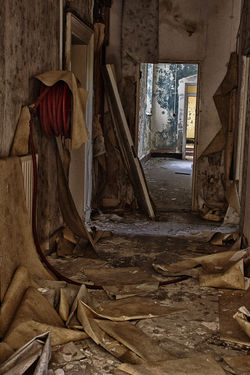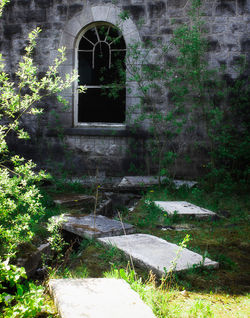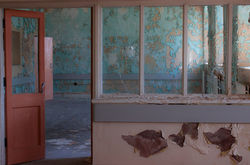Sandrine Josso Photography
Our Lady's hospital,
Ennis, Co. Clare

 |  |  |
|---|---|---|
 |  |  |
 |  |  |
 |  |  |
 |  |  |
 |  |  |
 |
Our Lady’s hospital site is situated in Gort road, very near the city of Ennis, Co. Clare. It first opened its doors in 1868 some extensions were made in the 1900. At the time it was known as Ennis District Lunatic Asylum. The hospital closed its doors in march 2002 and it is now for sale.The site is listed as protected structure under the Ennis Developement plan 2008-2014 and as an architectural conservation area.
I made several visits to the site, it was easely accesible and busy, I met few people walking around with their dogs. Some buildings seems really in advanced decay, others a little bit less. The first visit, a gloomy rainy day, I was able to enter the premisses through a broken window and managed to take few photos from the inside. Being inside at first was very creepy, very dark and I recall staying on the spot for several seconds trying to record every sound I could possibly hear, before making few small steps. After a while I started to get more adjusted to the darkness of the place. But that's when an alarm came blaring all around. My heart jumped and I ran back the same way I came from, passing that high window with no problem at all !
On the second visit, it was a sunny day, which made the place a little less haunting, I found other ways to look inside. Our lady's hospital site is surrounded by other businesses and I could hear people chatting around while I was crawling through broken doors inside. I didn't want to trigger the alarm again so I just stayed close to my entry point, I didn't take a walk inside.
It looked empty each time I glanced, no artifacts, no furnitures, only walls, windows...
On the third visit, hoping to spot the guard, I wandered around the building, asking around. Apparently lot of locals visited inside our Lady's without major problem. The alarm might goes off but without consequences. So I decided then to go inside through a broken door and explore what I could. The smell was strong and some area very dark. Thanksfully it was a beautiful morning and the sun was shinning through amazing windows. I met a couple looking around. They told me the place was haunted. I went up some stairs but obviously too close from the main part, I triggered the alarm. I kept shooting nonetheless until I had enough of the atmosphere.
(Photos from inside Our Lady's down below)
Searching the net, for more information about the history of Our Lady's I learned that Clare County Archives has launched in 2002 a "oral history project" since the closure of Our lady's hospital. The recording is about the care of patient and the different changes in the hospital management from 1940's until 2002.
From the opening until the 1950´s very little change was notice in the way the hospital was managed and we can assume that Our lady's was unfortunately a place with all the flaws of its time (see also Saint Brigid's asylum, Ballinasloe) : overcrowded, no drugs therapy available, difficult patients were restrained... :
“One former charge nurse recalled his impressions of the day room on his first day of work in a disturbed ward as a vision from hell, which frightened him terribly. Another charge nurse recalls in great detail a very similar picture, while both soon became quite used to it. Another nurse recalled the advent of drug therapy describing Largactyl as a wonder drug’, which allowed some previously chronic patients to go home. These were also the days of Electric Convulsive Therapy without anaesthetic, and insulin therapy, both of which methods are described in the interviews.”
Those interviews carried out by the Clare County Archives will give us an insight of how Our lady's hospital Ennis was managed, how mental health was approached at the time and hopefully those valuable informations will be used as a guide to develop a genuine and constant commitment to improve the care of people who suffer and are labeled "mentally ill".
More reading here :http://www.clarelibrary.ie/eolas/library/developments/oral_history_project.htm
 |  |  |  |  |
|---|---|---|---|---|
 |  |  |  |  |
 |  |  |  |  |
 |  |  |  |  |
 |  |
Kate Millet, a feminist american writter mentioned in her book "The loony Bin Trip" being committed in Our Lady's hospital Ennis in the 80's while in Ireland. She was supporting the Hunger strike and gave a speech about the torture of political prisoners. Kate Millet was arrested by the police in Shannon airport and brought to Our Lady's. She said she was arrested for her political comitments not for her behavior, she suffered from manic depressive disorder (bipolar) and used to be on lithium.
She was release from Our lady's after three weeks thanks to the pressure of locals feminists and politicians.
Kate Millet in her book describes her experience of hospitalisations for bipolar disorder :
"Socially unacceptable behavior is taken as a symptom, even proof, of pathology." If people stray from "acceptable" behavior they're quickly stigmatized as crazy and labeled with mental "diseases such as paranoia, schizophrenia and manic depression."
" Were you truly insane?
- No," she said. "I think I've had unusual experiences, happy and unhappy ones. But I was not mad. Madness is manufactured when psychiatry intervenes."
Much of Millett's book covers what she describes as nightmarish experiences in mental wards in Minnesota, the Bay Area and Ireland.Psychiatry is portrayed as "a terrifying form of social control," and Millett describes her loved ones--who twice put her in mental hospital--as having little concern for her health."My God, they are going to turn me in. . . ." Millett wrote. "This is the labyrinth I am entering. For the rest of my life, I will wear this mark on my forehead."